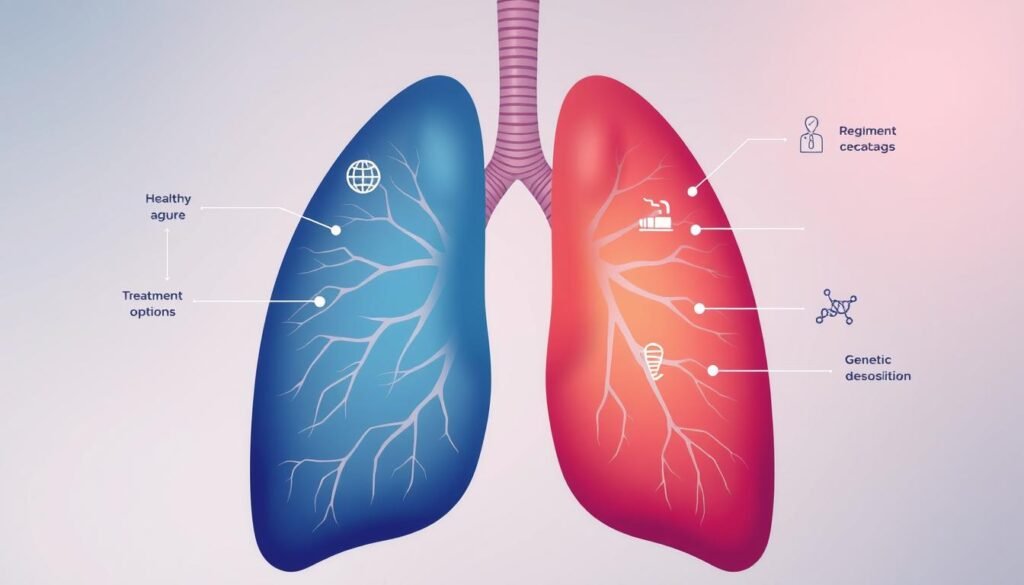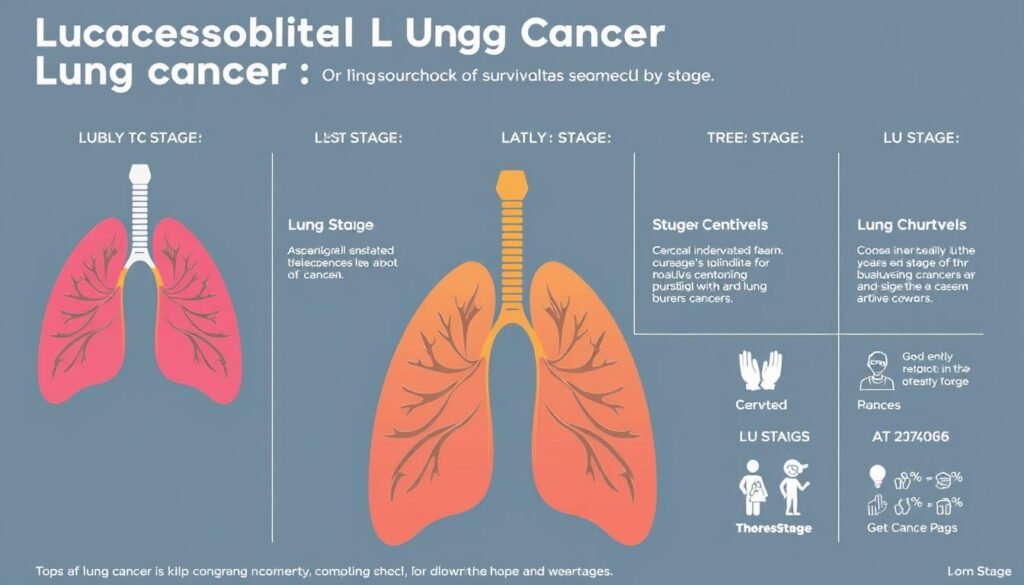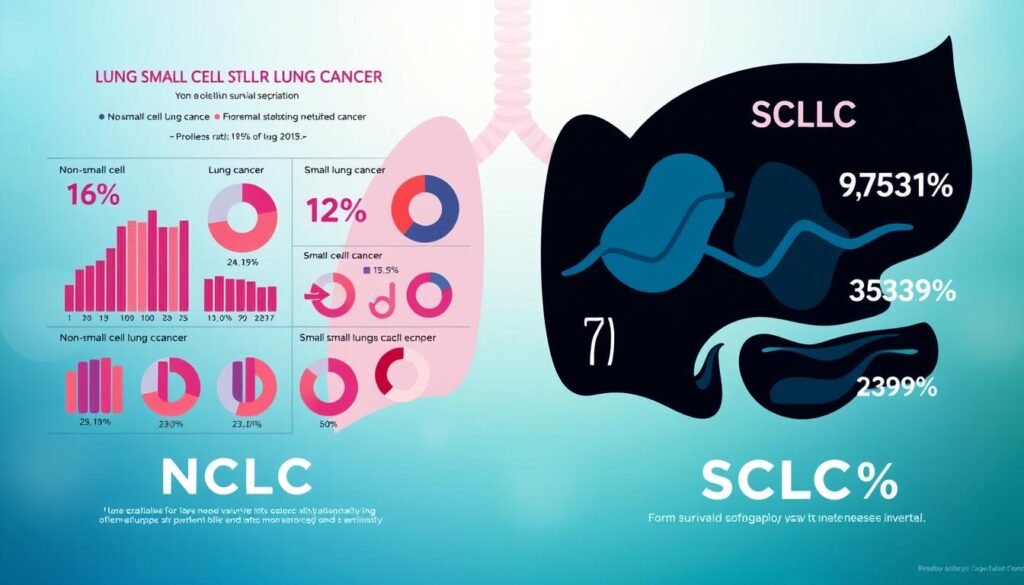Lung cancer’s 5-year survival rate is sadly less than 20%, making it as deadly as liver cancer. This fact shows how crucial it is to grasp lung cancer survival rates. About 40% of these cases are found at stage IV, the most advanced stage. Knowing these statistics helps patients and their families make sense of lung cancer’s future outcomes.
These stats come from trusted groups like the American Cancer Society and the National Cancer Institute. They use the SEER database to provide survival expectations based on past data. However, it’s key to know that these figures offer an overall view, not a personal prediction. Every patient’s experience is different, influenced by various factors.
This piece will dive deeper into how lung cancer survival rates are calculated. It will also look at what can change a person’s prognosis.
Key Takeaways
- The 5-year survival rate for lung cancer is below 20%, indicating its severity.
- Over 40% are diagnosed at the advanced stage IV, emphasizing the need for early detection.
- Data from the SEER database is critical for understanding lung cancer survival statistics.
- Survival rates provide a general guide but can’t predict each individual’s journey.
- Factors like age, health, and treatment response significantly influence lung cancer prognosis.
What are Lung Cancer Survival Rates?
Lung cancer survival rates are key for understanding patient outcomes after diagnosis. They mainly look at the 5-year survival rate. This rate shows the percent of patients alive five years after finding out they have cancer.
Different stages of lung cancer have different survival rates. For those with lung cancer that hasn’t spread, about 59% live past five years. But, this drops to about 31% for cancer that has spread nearby. It falls even more, to 6%, for cancer that has spread far. Overall, only about 19.5% of patients live five years after their diagnosis. This shows why finding cancer early is crucial.
Men and women might have different survival rates, but the difference is small. Age also plays a big role in survival rates. Younger patients, especially those under 55, tend to live longer, with a 5-year survival rate of up to 26%.
Survival rates for lung cancer are getting better over time. This is thanks to ongoing research and better treatments. Knowing about lung cancer death rates highlights the importance of screenings. Yet, in 2022, only a few people at high risk got screened. This points to a need for more screenings.
Here’s a summary of lung cancer survival rates by stage:
| Stage | 5-Year Survival Rate |
|---|---|
| Localized | 59% |
| Regional | 31% |
| Distant | 6% |
| Overall | 19.5% |
Understanding How Survival Rates are Calculated
Studying lung cancer survival rates means looking at a lot of history from past patients. This info is gathered by groups like the National Cancer Institute. They look at how well treatments work, who gets sick, and how the disease changes over time. Survival rates show us the percent of patients who live for a certain time after finding out they’re sick. To find these numbers, doctors divide how many patients are still alive by the total number who were diagnosed.
It’s important to remember that these numbers are just averages. A lot of different things can change a patient’s outlook, like their overall health or the kind of treatment they get. The five-year survival rate tells us the percent of patients living five years after diagnosis. But, even after five years, some patients may face the cancer coming back. So, these numbers give us a look into possible outcomes but might not tell everyone’s story perfectly.
In real life, patients use survival rates differently. Some find hope in the numbers, while others might feel overwhelmed. It’s key that doctors talk to patients in a way that fits what they need to hear, since everyone’s journey with the disease is unique. Talking options through with doctors often helps more than just looking at stats.
Factors Influencing Lung Cancer Prognosis
Several factors greatly affect the outcome of lung cancer treatment. These include the cancer type, its stage when found, and the patient’s health. Knowing these parts is key for proper disease control and prediction.
Genetic changes in tumors influence therapy success. Therefore, people with late-stage lung cancer may not have the same lung cancer cure rates as those found early. A patient’s age, whether they smoke, their weight changes, and health status matter too.
The link between tumor quality and death risk is strong. Patients with less distinct carcinoma face higher death chances than those with clearer tumors. It shows why treatments should match each patient’s health needs.
Studies show new treatments and catching cancer early can boost survival chances. Even simple changes, like adding vitamins or minerals, might lower death risks. For more on prognosis factors, click here.

Survival Rates of Lung Cancer by Stage
Lung cancer survival rates vary a lot. They depend on the cancer stage when diagnosed. Knowing these rates helps guide treatment choices and what to expect about life expectancy. The SEER database offers important data on survival for each stage. It helps patients and doctors make better decisions.
Localized Stage
The localized stage means cancer is only in the lung. If found at this stage, there’s a 62.8% chance of living five more years. This shows how key early detection is. It boosts chances of living longer and treatment working better.
Regional Stage
At the regional stage, cancer has spread to nearby lymph nodes. Here, the five-year survival rate drops to 34.8%. This shows why acting fast is vital when cancer begins to spread.
Distant Stage
When cancer reaches the distant stage, it has spread far, like to other organs. The five-year survival rate plummets to 8%. This big fall in survival rates shows the hurdles in treating advanced cancer. Early diagnosis and new treatments could improve these numbers.
| Stage | Five-Year Survival Rate |
|---|---|
| Localized | 62.8% |
| Regional | 34.8% |
| Distant | 8% |
Further, non-small cell lung cancer (NSCLC) has a 65% survival rate if localized. But for regional and distant stages, rates fall to 37% and 9%. Small cell lung cancer (SCLC) has a 30% survival rate when local but just 3% when distant. Early detection and treatment are key for better survival rates. For more information, see the SEER database.

Lung Cancer Survival Statistics: NSCLC vs. SCLC
Lung cancer comes in two main types: non-small cell lung cancer (NSCLC) and small cell lung cancer (SCLC). It’s vital to know their survival statistics to make informed choices about treatment. NSCLC makes up about 80% to 85% of cases, while SCLC accounts for 10% to 15%. The survival rates between these types vary a lot, affecting patient outcomes.
Non-Small Cell Lung Cancer (NSCLC)
The chance of surviving NSCLC depends on how early it’s found. For early-stage NSCLC, the 5-year survival rate can be up to 64%. But, this number drops sharply for more advanced stages. For example, the survival rate falls to 2% to 13% at stage 4. Early detection and treatment are key. Understanding NSCLC survival stats helps patients and doctors plan better treatments.
Small Cell Lung Cancer (SCLC)
SCLC grows fast and has lower chances of survival. Overall, only less than 5% of patients survive beyond 5 years. If found early, the survival rate might increase to 29%. However, if it spreads widely, the survival rate drops to about 1%. Almost all SCLC cases are linked to smoking, highlighting the importance of stopping smoking and raising awareness. Studying these survival rates can lead to custom treatments that improve life quality.

| Cancer Type | Stage | 5-Year Survival Rate |
|---|---|---|
| NSCLC | Localized | 64% |
| NSCLC | Distant | 2-13% |
| SCLC | Localized | 29% |
| SCLC | Extensive | 1% |
The Impact of Lung Cancer Treatment on Survival Rates
Lung cancer treatments can lead to different outcomes. The type of treatment can greatly impact survival and remission rates. It’s important for both patients and doctors to understand these options.
Types of Treatments Available
The main treatments for lung cancer are:
- Surgery: This might involve removing the tumor and sometimes the tissue around it.
- Radiation Therapy: It uses high-energy waves to target cancer cells.
- Chemotherapy: This includes powerful drugs aimed at cancer cells.
- Targeted Therapies: These drugs target specific mutations in lung cancer.
- Immunotherapy: It boosts the immune system to fight cancer better.
Treatment choice depends on the cancer stage and patient health. Each type offers different outcomes for lung cancer treatment.
Recent Advances in Treatment Options
There have been big advancements in lung cancer treatments, especially for NSCLC. These improvements have led to lower mortality rates. The National Cancer Institute reports better survival rates for NSCLC patients. Thanks to personalized medicine and better chemotherapy, remission rates are also up.
Clinical trials offer hope for advanced lung cancer patients. Research shows a 26% improvement in survival rates over five years. This highlights the importance of ongoing research for better treatments.
| Treatment Type | Effect on Survival (%) |
|---|---|
| Surgery | Highest survival rates |
| Chemotherapy | Improves outcomes in advanced stages |
| Radiation Therapy | Benefits localized cancer |
| Immunotherapy | Emerging success in specific patient groups |
| Targeted Therapies | Effective for mutations in NSCLC |
Advanced treatments are key to better outcomes in lung cancer treatment. They are shaping future fights against the disease. For more information on lung cancer therapies, check out this study.
Lung Cancer Life Expectancy Factors
Various factors play a key role in determining the life expectancy of lung cancer patients. The patient’s age and overall health are crucial considerations. They often influence the body’s resilience to treatment and disease recovery. Generally, younger people have a better chance of overcoming lung cancer. This is because they tend to have fewer other health issues.
Age and Overall Health
Studies show that patients under 50 usually have better survival rates than those over 65. For older patients, life expectancy with lung cancer drops significantly. But, individuals who are in good health overall respond better to treatments. This response can greatly improve their chances in the long run. It’s important for treatments to be customized for each person’s health situation.
Response to Treatment
The way patients respond to lung cancer treatment affects their life expectancy. Successful treatments like surgery, chemotherapy, and immunotherapy can extend life. For example, patients with non-small cell lung cancer who undergo surgery might live about 76.7 months. However, those with advanced NSCLC who don’t get treated may only have around 9 months. This shows how vital timely and suitable care is for survival.
Conclusion
Knowing about lung cancer prognosis is crucial for patients and their families. It helps shape what they expect and make informed choices. Even though there are tough statistics, like 160,340 deaths in the U.S. in 2012, there is hope. The 1-year survival rate went up from 35% in 1975-79 to 42% in 1988-2008.
New treatments and research bring more tailored care plans. Lung cancer screenings play a big role in saving lives. They can cut down death rates a lot. So, it’s really important to get more people at risk screened early on.
The medical world is always changing, and keeping up with lung cancer information is key. This knowledge lets patients take charge of their health for better results. Together, with knowledge and care, we face lung cancer’s challenges.